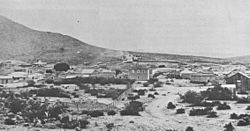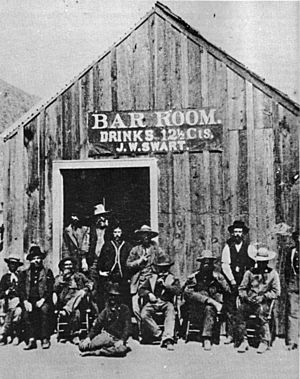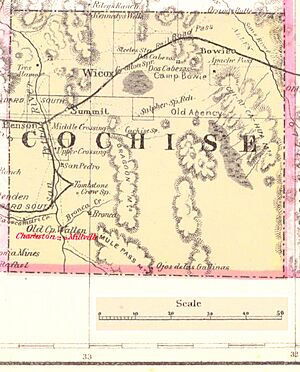Charleston, Arizona facts for kids
Quick facts for kids
Charleston, Arizona
|
|
|---|---|

Charleston, circa 1885
|
|
| Country | United States |
| State | Arizona |
| County | Cochise |
| Founded | 1879 |
| Abandoned | 1888 |
| Named for | Charles D. Handy |
| Elevation | 3,989 ft (1,216 m) |
| Population
(2009)
|
|
| • Total | 0 |
| Time zone | UTC-7 (MST (no DST)) |
| Post Office opened | April 17, 1879 |
| Post Office closed | October 24, 1888 |
| GNIS feature ID | 24360 |
Charleston was a ghost town in Cochise County, Arizona. It was active from the late 1870s to the late 1880s. This town was located in what was then called the Arizona Territory. Charleston sat on the west bank of the San Pedro River. Its economy relied on processing silver ore. This ore came from nearby Tombstone. The processing happened in a community called Millville, right across the river.
Contents
Where Was Charleston Located?
Charleston was found at 31°38′9″N 110°10′21″W / 31.63583°N 110.17250°W. It was on the west side of the San Pedro River. The town was about 9 miles (14 km) southwest of Tombstone. Millville was located directly opposite Charleston, on the east bank of the river.
The Story of Charleston
Charleston was first settled as a home for workers. These workers were employed at the mills in Millville. Two mills were built there to process silver ore. This ore came from the silver mines near Tombstone. The mills were built in Millville because Tombstone did not have enough water. Water was needed to refine the silver.
The mills started working in 1879. One mill was run by the Tombstone Mill and Mining Company. The other was run by the Corbin Mill and Mining Company. They processed silver ore into a fine powder. This was done before the silver was melted down. At their busiest, from 1881 to 1882, they processed nearly $1.4 million in silver in one year.
Amos Stowe claimed the land for Charleston on October 28, 1878. Planning for the town began right away. The town had 26 blocks, each with 16 lots. Businesses quickly moved to Charleston. By May 1879, the town had about 40 buildings. A post office opened on April 17, 1879. Millville's post office opened later but closed less than a year after. Charleston became the main place for people from both towns to live. Millville was named for its mills. Charleston was named after its first postmaster, Charles D. Handy.
The 1880 United States Census counted 350 people in Charleston. The town's population likely grew to over 400. This happened during the peak of Tombstone's silver boom. At its busiest, Charleston had many businesses. These included four restaurants and a school. There was also a church, a doctor, and a lawyer. The town had a drugstore, two blacksmiths, and two livery stables. There were two butcher shops and two bakeries. A hotel, five general stores, and a jewelry shop also existed. Other businesses included a carpenter, a brickyard, a brewery, and at least four saloons. Famous frontier lawman John H. Slaughter owned one of the butcher shops.
Charleston's Reputation
Charleston had a reputation for being a bit wild. This idea was often spread by newspapers back east. Some well-known figures of the time were connected to the area. For example, the Clanton Ranch was just five miles south of town. This ranch was run by the Clanton family.
Despite its reputation, the town was often peaceful. No successful robberies of silver or money were ever recorded. The Tombstone Epitaph newspaper said in 1882 that Charleston was "well regulated and free from turmoil." It also called it "one of the most peaceful places we were ever in."
Charleston was also known for its Justice of the Peace, James Burnett. Burnett was known for his unusual way of handling justice. He would often settle disputes right on the spot. He would collect fines himself, which could be anything from cattle to money. Burnett became a very powerful figure in Charleston. He stayed in charge until the town was abandoned around 1889.
Why Charleston Became a Ghost Town
The silver mines in Tombstone flooded in 1886. This forced the mills in Millville to close down. As a result, Charleston and Millville began to decline rapidly. A large earthquake struck on May 3, 1887. It was followed by over thirty minutes of aftershocks. This earthquake ruined all the town's adobe buildings. The town was quickly abandoned because no buildings were safe to live in. The Charleston Post Office closed on October 24, 1888. By 1889, both Charleston and Millville were already ghost towns.
What's Left of Charleston Today?
After it was abandoned, Charleston was briefly home to Mexican immigrants in the 1890s. They used the remaining wooden structures for firewood. Later, during World War II, the United States Army used Charleston for practice. Soldiers from nearby Fort Huachuca practiced urban combat there. They sometimes used live ammunition. These activities, around 1943, caused more damage to the site. The town's location right on the San Pedro River also caused problems. The river's cliffs eroded, slowly washing away the land and the adobe ruins.
Today, only a few adobe ruins and stone foundations remain. They are mostly hidden among the plants. Across the river in Millville, only a few stone walls are left of the mills. The local cemetery is about a mile and a half north of Charleston. It is hard to find, and very few traces are left. The site is now part of the San Pedro Riparian National Conservation Area. This area is managed by the Bureau of Land Management.
Charleston and Millville cannot be reached by car. You can only get there by hiking along the San Pedro River. For many years, the trails were rough and hard to follow. However, the Bureau of Land Management has started to maintain trails to the area. The remains of Charleston are on the west bank of the river. Millville's ruins are directly across on the east bank.





